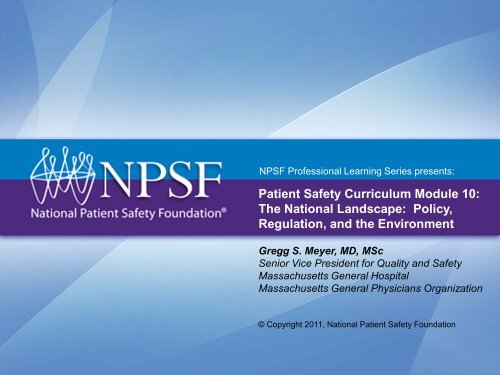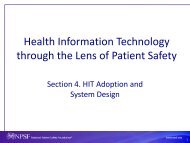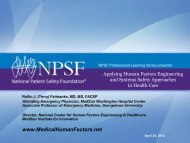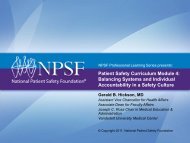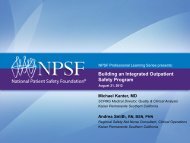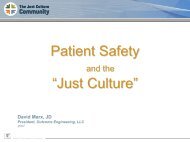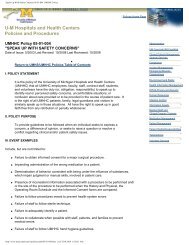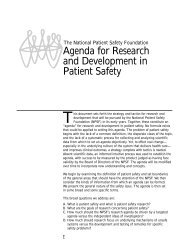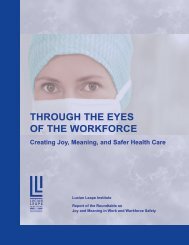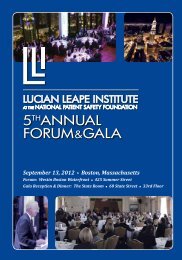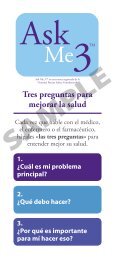Patient Safety Curriculum Module 10: The National Landscape ...
Patient Safety Curriculum Module 10: The National Landscape ...
Patient Safety Curriculum Module 10: The National Landscape ...
- No tags were found...
Create successful ePaper yourself
Turn your PDF publications into a flip-book with our unique Google optimized e-Paper software.
NPSF Professional Learning Series presents:<strong>Patient</strong> <strong>Safety</strong> <strong>Curriculum</strong> <strong>Module</strong> <strong>10</strong>:<strong>The</strong> <strong>National</strong> <strong>Landscape</strong>: Policy,Regulation, and the EnvironmentGregg S. Meyer, MD, MScSenior Vice President for Quality and <strong>Safety</strong>Massachusetts General HospitalMassachusetts General Physicians Organization© Copyright 2011, <strong>National</strong> <strong>Patient</strong> <strong>Safety</strong> Foundation
<strong>Module</strong> <strong>10</strong>: <strong>The</strong> <strong>National</strong> <strong>Landscape</strong>:Policy, Regulation and the EnvironmentThis presentation covers the external influences in thefield of patient safety by exploring new and emergingtrends in healthcare policy at the federal, state, and locallevels. Participants will learn the functions of externalagencies and regulatory bodies, discuss effectivestrategies for meeting reporting requirements, and learntechniques for optimizing operational systems andprocesses to assure compliance with industry standardssuch as the <strong>National</strong> <strong>Patient</strong> <strong>Safety</strong> Goals (NPSGs) andaccreditation requirements.2NPSF Professional Learning Series
Goals of this module• Upon completion of this module participants will be able to:• Explain the role of external agencies, regulators andstandard-setting bodies in the field of patient safety• Summarize current healthcare policies and initiatives anddescribe their impact on clinical practice• Design and implement process to meet NPSGs and complywith other industry standards and guidelines3NPSF Professional Learning Series
Regulatory and Policy Context4NPSF Professional Learning Series
“End result system of hospitalstandardization”Ernest A.Codman, MD5NPSF Professional Learning Series
More Recent Calls for an End ResultSystem6NPSF Professional Learning Series
<strong>Patient</strong> <strong>Safety</strong> in the Popular Press7NPSF Professional Learning Series
Variations in Care Are Widespread<strong>The</strong> Cost ConundrumWhat a Texas town can teach usabout health care.Atul Gawande, June 1, 20098NPSF Professional Learning Series
<strong>The</strong> Cost <strong>Landscape</strong>• Per capita healthcare costshave grown steadily for 40years• Private insurance payerssubsidize underpayments byMedicare, Medicaid, and theuninsured• Chronic disease andtechnology are the primarydrivers of cost• Proposals to extend healthinsurance coverage magnifycost pressuresPer Capita NHE in $35003000250020001500<strong>10</strong>005000Per Capita Growth In Health ExpendituresHas Increased at 2.5% Above Inflation For40 Years(adjusted for inflation)1966196819701972197419761978198019821984198619881990199219941996199820002002200420069NPSF Professional Learning Series
Two Views on Quality vs. CostSource: Baicker, K, and Chandra, M. Medicare spending, the physicianworkforce and beneficiary quality of care. Health Affairs. April 7, 2004.<strong>10</strong>NPSF Professional Learning Series
Mounting Pressures for Transparencyand Accountability<strong>National</strong>:AQA/HQATJCNSQIPUS News and World ReportQASCAMA andSpecialty SocietiesNCQA/HEDIS<strong>National</strong> Quality ForumAHRQCMS (including seriousreportable events and P4P, ? ACOs)LeapfrogMeaningful Use11NPSF Professional Learning Series* a sample!
Mounting Pressures for Transparencyand AccountabilityRegional:Tiered Regional NetworksRegionalPublications<strong>National</strong> Insurers(United, Cigna,Aetna)Commercial website vendors(Subimo, Healthshare,HealthGrades, MD rating sites)UHC, VHA, etc.12NPSF Professional Learning Series
Mounting Pressures for Transparencyand AccountabilityState:Dept of Public HealthLocalMagazinesBoard ofRegistrationInsurance DataMHQPBeacon Communities Project13NPSF Professional Learning Series
Mounting Pressures for Transparencyand AccountabilityPayors:Tiered NetworksPayor Open-EnrollmentMaterialsPayor WebsitesP4P Data14NPSF Professional Learning Series
Mounting Pressures for Transparencyand AccountabilityInternal to Organization:Care RedesignHigh Performance Medicine MetricsPCACOPPE/FPPEDepartmental QualityWorkCredentialingQuality WebsitesQuality Incentive ProgramsQuality and <strong>Safety</strong> Dashboards15NPSF Professional Learning Series
Mounting Pressures for Transparencyand AccountabilityCare RedesignAQA/NQA Tiered NetworksDept of Public HealthTiered Regional Networks TJCNSQIP US News and World Report<strong>National</strong> InsurersPHS High Performance Medicine Close (United, Aetna)RegionalAMA andPublications PCACBoard ofRegionalSpecialty SocietiesRegistrationPayor Open-EnrollmentMagazines(Boston)PHS Quality CloseMaterialsLeapfrogNCQA/HEDIS Departmental QualityPayor Websites<strong>National</strong> Quality Forum WorkMGPO Quality Incentive ProgramGIC Insurance DataCommercial website vendors CMS (with P4P coming soon)UHC(Subimo, Healthshare,P4P DataMHQPHealthGrades AHRQCredentialingQuality and <strong>Safety</strong> Dashboard16NPSF Professional Learning Series
Regulatory <strong>Landscape</strong>17NPSF Professional Learning Series
Regulatory Agencies• Centers for Medicare and Medicaid Services• Joint Commission• State Departments of Public Health• Centers for Disease Control and Prevention• Food and Drug Administration• Office for Civil Rights – HIPAA• OSHA• Voluntary Reviews (e.g., Magnet Survey by ANCC)18NPSF Professional Learning Series
Example of One Year of PotentialRegulatory VisitsAgency Purpose Survey IntervalDMH Inpatient Psych Unit licensure 2 yearsDPH Infection Control unknownTJC Ventricular Assist Device survey 2 yearsFDABlood bank inspection including bloodadministration tracer2 yearsDPH Bureau of SubstanceAbuse ServicesSubstance Abuse Clinic occasional sitevisits~annualDPH ESRD program re-certification 3 yearsDPH Radiation Control - Cath and EP Lab 2 yearsAABBBlood bank inspection including bloodadministration tracerannualCollege of AmericanPathologists Fertility lab inspection 2 years19NPSF Professional Learning Series
Regulatory Agencies• Rightful role• Our need to change the tenor of the conversation• Sometimes recommendations can be conflicting• E.g., Office for Civil Rights, through enforcing HIPAA, can inhibitability to be transparent20NPSF Professional Learning Series
<strong>The</strong> Joint CommissionDPHCMS<strong>The</strong> Regulatory Food ChainYou21NPSF Professional Learning Series
CMS Conditions of Participation (CoP)1. Compliance with Federal, State andlocal laws13. Physical environment2. Governing body 14. Infection control3. <strong>Patient</strong>’s rights 15. Discharge planning4. Quality assessment andperformance improvement program16. Organ, tissue, and eye procurement5. Medical staff 17. Surgical services6. Nursing services 18. Anesthesia services7. Medical record services 19. Nuclear medicine services8. Pharmaceutical services 20. Outpatient services9. Radiologic services 21. Emergency services<strong>10</strong>. Laboratory services 22. Rehabilitation services11. Food and dietetic services 23. Respiratory care services12. Utilization review? Future Update22NPSF Professional Learning Series
Potential CMS CoP Findings• Condition level findings• Immediate jeopardy• Standards level findings23NPSF Professional Learning Series
Joint Commission24NPSF Professional Learning Series
Influences on the Joint CommissionSurvey ProcessGovernmental agenciesConsumer groupsWatchdog groupsHealth CareOrganizationsJoint CommissionConstant Evolution25NPSF Professional Learning Series
Evolution of JC Surveys – NewPathways (2004)• Shared Vision – Safe, high-quality care• New Pathways – New approaches to the accreditationprocess• Customized survey process• Tracer methodology (2004)• Unannounced survey process (2006)• Periodic performance review• Reorganized standards (2009)• New approach to scoring and decision processMedical CareMultidisciplinary Care26NPSF Professional Learning Series
Customized Survey Process• Priority Focus Process – automated, rule-based toolthat aggregates the following:• Clinical service groups and DRGs, e.g., cardiology, vascularsurgery, oncology• ORYX data (heart failure, heart attack, pneumonia, etc.)• Sentinel event data• Past findings• <strong>Patient</strong> complaints• Uses this information to determine what to survey,length of survey, number of surveyors27NPSF Professional Learning Series
Tracer Methodology• Cornerstone of the JC survey process• Surveyors follow the experience of care for the patientsthroughout the hospitalization• Evaluate processes of care through record review, staffinterview, patient interview, and observation• Compare care with standards and <strong>National</strong> <strong>Patient</strong><strong>Safety</strong> Goals28NPSF Professional Learning Series
“Tracing” the <strong>Patient</strong>: Across SitesAdmittingEDStep downDiagnostic TestsPre-hospitalcareICUORInterventionalAreasGeneral UnitsHome29NPSF Professional Learning Series
“Tracing the <strong>Patient</strong>”: AcrossDepartmentsLaboratoryNursingMedicalPTPharmacyOTInterpreterChaplaincyRTTransportTransfusionSocial WorkCase Management30NPSF Professional Learning Series
“Tracing” the <strong>Patient</strong> – Priority FocusAreasAssessment and Care/ServicesCommunicationInfection ControlMedication Management<strong>Patient</strong> RightsEquipment UseStaffing and CredentialingOrientation/TrainingInformation ManagementOrganizational StructurePhysical Environment<strong>Patient</strong> <strong>Safety</strong>Infection ControlQI Activities31NPSF Professional Learning Series
Example: <strong>Patient</strong> s/p MVA37-year-old male with history of substance abuseUnitServices•ED•SICU•OR•White 7•Nursing•PT•Social work•Pharmacy•Labs/Diagnostics•Case Management•Addiction Services32NPSF Professional Learning Series
Sample: Unannounced SurveySchedule — Day 1Time Physician Nurse Administrator Generalist8:00-9:00 a. Surveyor arrival and Preliminary Planning Session9:00- <strong>10</strong>:00 a. Opening Conference and Orientation to the Organization<strong>10</strong>:00-.11:00 a. Continued Surveyor Planning Session11:00-12:30 a. IndividualTracerActivityIndividualTracerActivity12:30-1:00 p. Surveyor Lunch1:00-3:30 p. IndividualTracerActivityIndividualTracerActivityIndividualTracer ActivityIndividualTracer ActivityIndividualTracerActivityIndividualTracerActivity3:30-4:00 p. Special Issues Resolution4:00-4:30 p. Surveyor Team Meeting/Planning Session33NPSF Professional Learning Series
Reporting and Response• Summary of Survey Findings Report will be left on siteafter survey• Official Survey Report will be posted on organization’ssecure extranet site with potential accreditation status• Response• Example: Pain assessment reassessment• Policies and procedures simplified• Initial pain assessment added to nursing data set• Procedure now allows pain assessment/reassessment to be documentedon flowsheet and/or in progress notes• Flowsheets modified to highlight the column for documenting pain score• Pilots have been initiated on some units• RNs attended the Pain Relief Champion Courseswww.jointcommission.org34NPSF Professional Learning Series
<strong>National</strong> <strong>Patient</strong> <strong>Safety</strong> Goals(NPSGs)35NPSF Professional Learning Series
NPSG Background• <strong>The</strong> <strong>National</strong> <strong>Patient</strong> <strong>Safety</strong> Goals (NPSGs) were established in 2002(became effective January 1, 2003) to address specific areas ofconcern in regard to patient safety• <strong>The</strong> Joint Commission’s (TJC) mission is to “continuously improve thesafety and quality of care delivered to the public through the provisionof healthcare accreditation.”• <strong>The</strong> NPSGs have related specific requirements for improving thesafety of patient care in healthcare organizations.• TJC requires accredited healthcare organizations implement NPSGsas appropriate to the services provided by the organization. Allaccredited health care organizations such as Hospitals, AssistedLiving, Home Care, Behavioral Health Care, Disease-Specific Care,Ambulatory, Laboratory, etc., are surveyed to evaluate theimplementation of these goals as they relate to the services of theorganization.36NPSF Professional Learning Series
2011 Hospital NPSGs• <strong>The</strong>re are six NPSGs for accredited hospital organizationsand a Universal Protocol.• 2011 revisions:• <strong>The</strong> Joint Commission revised four Elements of Performance (EPs) withinthe Goals.• <strong>The</strong> revised EPs are effective immediately.• NPSG #8 on medication reconciliation is not included in the changes;additional work is being done to evaluate and refine the medicationreconciliation expectations for accredited organizations.• Goal 14: <strong>The</strong> goal of preventing healthcare-associated pressure ulcers(decubitus ulcers) has now become a STANDARD!!• Goal 9: <strong>The</strong> goal of reducing patient harm resulting from falls has nowbecome a STANDARD!!37NPSF Professional Learning Series
2011 NPSGs• Goal 1: Improve the accuracy of patient identification.• Use at least two patient identifiers when providing care, treatment, and services.• Eliminate transfusion errors related to patient misidentification.• Goal 2: Improve the effectiveness of communication among caregivers.• Report critical results of tests and diagnostic procedures on a timely basis.• Goal 3: Improve the safety of using medications.• Label all medications, medication containers, or other solutions on and off the sterilefield, in perioperative and other procedural settings.• Reduce the likelihood of patient harm associated with use of anticoagulant therapy.• Maintain and communicate accurate patient medication information (effective 7/1/11).• Goal 7: Reduce the risk of healthcare-associated infections.• Implement evidence-based practices to prevent healthcare-associated infections dueto multiple drug-resistant organisms in acute care hospitals.• Implement best practices or evidence-based guidelines to preventcentral line–associated bloodstream infections.• Implement best practices for preventing surgical site infections.• Goal 15: <strong>The</strong> organization identifies safety risks inherent in its patient population.• Identifying individuals at risk for suicide• Universal Protocol• Conduct a pre-procedure verification process.• Mark the procedure site.• Perform time out.38NPSF Professional Learning Series
Goal 8: Reconcile Medications• Accurately and completely reconcile medications across thecontinuum of care.• <strong>The</strong> implementation date for the revised medicationreconciliation requirement for NPSG 8 will be July 2011.• NPSG.08.01.01: Comparing Current and Newly OrderedMedications• NPSG.08.02.01: Communicating Medications to the NextProvider• NPSG.08.03.01: Providing a Reconciled Medication List tothe <strong>Patient</strong>• NPSG.08.04.01: In settings where medications are usedminimally, or prescribed for a short duration, modifiedmedication reconciliation processes are performed.39NPSF Professional Learning Series
Universal ProtocolUniversal Protocol for PreventingWrong-Site, Wrong-Procedure,Wrong-Person Surgery• UP.01.01.01: Conduct a pre-procedure verification process.• UP.01.02.01: Mark the procedure site.• UP.01.03.01: A time-out is performed before the procedure.40NPSF Professional Learning Series
Managing Regulatory Visits41NPSF Professional Learning Series
Managing Regulatory Visits• You will play a central role in managing regulatory visitsto your organization.• This is a challenging role since healthcare organizationregulatory surveys are numerous, varied, and oftenunannounced.• Four steps to the regulatory visit cycle1. Prepare for the next survey.2. Oversee the survey.3. Develop necessary plans of correction.4. Monitor compliance with the plan.• Doing a good job of managing this cycle will result insuccessful surveys and a stronger safety program.42NPSF Professional Learning Series
<strong>The</strong> Regulatory Survey CycleMonitorcompliancewith planPrepare forsurveyDevelopcorrectiveaction planOverseesurvey43NPSF Professional Learning Series
Signals That Drive Focus of RegulatoryManagementCMS“<strong>The</strong> Buzz”*DPH* Priorities set by professionalsocieties, patient safety objectives,institutional goals, etc.OrganizationalCoordinatingCommitteeConsultants(ex. Greeley and JCR)SeriousEvents<strong>The</strong> JointCommission44NPSF Professional Learning Series
Survey Preparations• Develop a regulatory readiness calendar to display allknown regulatory visits anticipated in the near future.• Share this calendar with leadership and other groups thatneed to know.• Surprises are not good, although sometimes they areunavoidable.• Even if you are surprised, try not to act it.• Restrain yourself from predicting when regulators will arrive.45NPSF Professional Learning Series
Arrival Instructions• Verification that front desk has been alerted• Notification of department leaders through pre-established group page• Where will the opening meeting take place and who will attend?• Who will escort the regulators?• What tools do escorts need?• What documents will regulators request?• Have suitable work space pre-selected and bring the regulators there.• Verify the regulators’ identities and agencies and have visitor badgescreated.• Assemble leadership and bring the regulators to an opening meeting.46NPSF Professional Learning Series
Opening Meetings• Getting off on the right foot is important.• Most regulators plan to have a formal opening meeting whereyou will learn the scope, focus, and duration of the visit. Insiston an opening discussion if it is not planned.• Have a standard slide deck prepared that gives generalinformation about your organization: size, locations, goals, etc.• Be proud to tell your story• Discuss your plans to provide escorts to the regulatorsthroughout their visit.• Ask the regulators to commit to informal daily debriefs.47NPSF Professional Learning Series
Survey Escorts• You need a team of experienced people who willaccompany surveyors as they travel throughout your facility.• Select and carefully match your escorts with regulators.• Coach your escorts prior to survey.• Be careful in providing regulators with policies.• Keep track of patient records reviewed.• Feedback any known issues to command central.48NPSF Professional Learning Series
Command Central (Bull Pen)• Large-scale surveys need a command center, behind the scenes, tomanage issues as they arise.• <strong>The</strong> command center serves several purposes:• A resource for escorts to call/email with problems, requests forpolicies.• A means to track issues as they arise and to quickly developresponses and strategies.• A communication group to keep leadership and staff informed asthe regulatory survey progresses.• Plan the command center with sufficient resources, sized to thesurvey (people, telephones, laptops).49NPSF Professional Learning Series
Daily Debriefs• Informal end-of-day discussions with the regulatoryteam gives you insight into where they perceive yourproblems to be.• <strong>The</strong>se daily debriefs provide an opportunity to correctregulator misperceptions and to discuss yourorganization’s efforts to improve performance.• Have internal (no regulators) daily debriefs immediatelyfollowing the regulators debrief.50NPSF Professional Learning Series
Exit Conference• At the exit conference you will hear a preliminary reporton the deficiencies the regulators are likely to assess.• Get leadership in the room.• Listen carefully, this is not the time to refute findings.But ask for clarification if a potential deficiency is notunderstood.• If the survey has been well managed nothing shouldsurprise you in the exit conference.51NPSF Professional Learning Series
Regulatory Plans of Correction• Begin developing plans of correction immediately followingsurvey. Do not wait to receive the report. Typically you willhave only <strong>10</strong> days from receipt to respond.• Regulatory plans of correction need to contain certainelements:• What has been done to address the deficiency?• What further steps will be taken?• On what date will those steps be completed?• How will you monitor implementation of the plan?• Who is responsible for implementation of the plan?52NPSF Professional Learning Series
Attributes of a Well ManagedRegulatory Visit• Leadership was aware of the upcoming visit and understood theorganization’s risk areas.• Efforts to address those risk areas were underway and could bedescribed.• Regulator arrival/opening meeting goes smoothly.• Escorts play their role competently.• Daily debriefs identify issues for possible resolution during survey.• No surprises in the closing meeting.• A plan of correction is in process before the regulator’s reportarrives.53NPSF Professional Learning Series
Moving Beyond RegulatoryReadiness toOngoing <strong>Safety</strong> Improvement54NPSF Professional Learning Series
Regulatory ReadinessPreparing for the Next Survey• Organizations need a defined process to prepare for upcoming surveys.• Shifting the mindset: It is not about being ready for the next survey, it is aboutbeing ready for the next patient.• Priority issues must be identified, plans to address developed, and progressmeasured continually.• Example: Established an Excellence Every Day Coordinating Committee as avehicle to assess organizational risk and to decide what leadership needed toknow.• Aim to be in a constant state of readiness for demonstrating compliance withstandards set forth by accrediting agencies such as the JC, DPH, ANCC, and CMS• Excellence Every Day Champion charges• Educate – TEACH!• Communicate – SHARE!• Motivate – INSPIRE!55NPSF Professional Learning Series
Universal Protocol Observational Audit ReportUniversal Protocol Observational Audit ReportJuly 1, 2009 - June 30, 20<strong>10</strong>Total observations = 2007<strong>10</strong>0%90%% Observations Completed Correctly80%70%60%50%40%30%20%<strong>10</strong>%0%CY09 Q3 CY09 Q4 CY<strong>10</strong> Q1 CY<strong>10</strong> Q2All Observations Pre-Procedure Verification Site-Marking Hard Stop Time-outCY09 Q3 CY09 Q4 CY<strong>10</strong> Q1 CY<strong>10</strong> Q2n % n % n % n %All Observations 335 90% 627 79% 471 94% 574 97%Pre-Procedure Verification 122 79% 264 58% 169 93% 199 93%Site-Marking 91 <strong>10</strong>0% 181 97% 134 97% 177 99%Hard Stop Time-out 122 93% 182 92% 168 93% 191 97%56NPSF Professional Learning Series
Quality and <strong>Safety</strong> FrameworkQuality• <strong>Safety</strong>• EffectiveEfficiency• Efficient• TimelyService• <strong>Patient</strong>-centered• EquitableProcess Improvement57NPSF Professional Learning Series
Capitalizing on CrisisSurprise check faults MGH quality of careBut hospital will get accreditationBy Liz Kowalczyk, Globe Staff | March 17, 2007“Inspectors found numerous quality of care problems atMassachusetts General Hospital during a surprise inspectionlate last year, noting concerns about medication safety,inconsistent handwashing by caregivers, and incompletemedical records.”58NPSF Professional Learning Series
Culture: Communications Plan forSurvey Findings59NPSF Professional Learning Series
TJC Report Posted on MGH Public Website60NPSF Professional Learning Series
Final Thoughts• B Teams with A Systems always beat A Teams with BSystems• It’s the system, stupid.• We need an A team, not A individuals, and we need to providethat team with A systems.• It’s not the seed, it’s the soil• Culture trumps all.• Innovation must be balanced with spread.• <strong>The</strong> political is much more challenging than the technical.• TPS Order of change: leaders -> professionals -> staff.• Data + Anecdote = Action• You need both.• Never waste a good crisis.61NPSF Professional Learning Series


